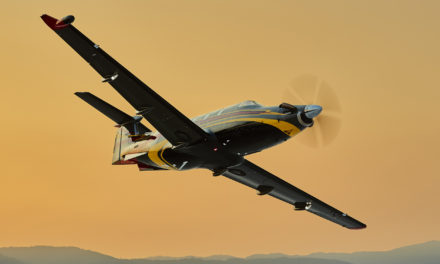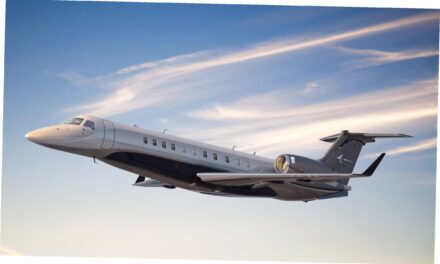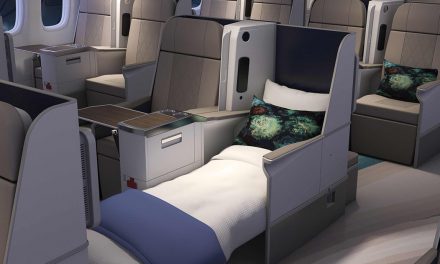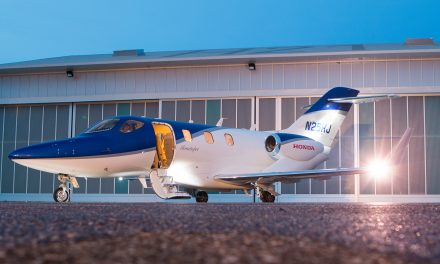The 2018 edition of Ebace will remain above all marked by the passing of Serge Dassault, aged 93, the day before the opening of the show. Due to this, the entrepreneur will no doubt be remembered a little more in the world of business aviation, for which he had been one of the most ardent defenders and contributors throughout his career at the head of Dassault Aviation.
It is logical that all the professionals paid him a heartfelt tribute during the opening ceremony of this essential business aviation event in Europe. Despite his passing, and a somewhat heavy atmosphere, the market as a whole showed signs of tangible recovery. More than 400 exhibitors made the trip from all over the world to present their know-how and 54 aircraft were displayed at the static exhibition.
The unanimity on a return of commercial exchanges was thus audible from operators as well as from manufacturers. The latter are beginning to take advantage of the decline in inventories on the second-hand market with prices revised upward on some second-hand models that have become rare. Indeed, we have seen in recent months a rare demand for some aircraft such as the Falcon 7X, making the tri-jet a plane difficult to find on the second-hand market. And de facto a cost reviewed upwards where at the same time the intermediate sector still knows no real recovery. This observation obviously benefits brokers, who confirm that at the moment “light and high-end sectors are booming.” According to Embraer, 9.1% of the world’s fleet was for sale on the second-hand market in the first quarter of 2018, compared with 10% last year for the same period. At the same time, the Brazilian manufacturer has announced a 17% increase in market transactions on these aircraft in the first quarter of this year.
5500, 6500 and 7500
With its strong sales figures and a market potentially focused on high-end, Bombardier has created a surprise by revealing not one but three new products in the Global range. The Canadian aircraft manufacturer has secretly developed two new versions based on its existing Global 5000 and 6000 bases, renaming them Global 5500 and 6500, which will be available on the market as of 2019. However, Bombardier indicated that these new versions will be inserted on the assembly lines of the 5000 and 6000 versions indicating by the same that they will preserve the original versions in the catalog in order to extend its offer.
Beyond the marketing aspect, these models benefit from an autonomy extension of 500 and 600 nm (926 and 1111 km respectively). These new performances have reaped the benefits of a brand-new wing specially developed to meet the aircraft manufacturer’s new requirements and the adoption of a brand-new engine built by Rolls-Royce, the Pearl. This combination resulted in a 13% gain over previous versions. These aircraft will be able to fly at Mach 0.85 with eight passengers on board and a distance of 5,700 nm for the Global 5500 and 6,600 nm for the 6500. The latter, whose first prototype was on show the day before the opening during an event to unveil the aircraft, will also adopt, like the 5500, the Vision Flight Deck avionics with a new architecture and a fiber optic connectivity system. Both will be equipped with a brand-new cabin designed around the nuage seat specially developed for the Global 7000.
The latter, whose program is still ongoing, takes the new denomination 7500. Third novelty announced by Bombardier during the show, this new version, which resembles the two previous, highlights the new performance of the 7000 found during the program test. The 7500 will have a range of 7,700 nm (14,260 km) against 7,400 (13,700 km) initially planned for. The new aircraft is expected to enter service in the second half of the year after certification testing and the end of flight tests, which allowed the five prototypes to complete more than 2,000 flight hours. In addition to its new range, the Global 7500 also has new landing and take-off performances that should enable it to be certified at London City Airport.
With these three novelties and a strong catalog of five aircraft the Canadian manufacturer plans to flood the very high-end market. But given some elements presented to the press, one question remains: will the Global 8000 be born? For the moment, Bombardier remains discreet on the subject and has not given any information on the program’s progress. It is therefore likely that the aircraft manufacturer, if it does not abandon the project, will give itself some time to measure the impact of its new range on the market before a real decision is made. Same for the Learjet range. After stopping the Learjet 85 program in 2015, Bombardier continues to drive the brand with only two models, the Learjet 70 and 75. But for how much longer? Because with 14 deliveries in 2017, the production of both models continues to decline year-on-year. For now, if the Canadian does not seem determined to launch a new program to relaunch the range, it has instead indicated that it has reorganized its teams to develop sales in the second-hand market where there is a large fleet of Learjets, all models combined.
Rolls-Royce launches the Pearl
The announcement of the launch of the Global 5500 and 6500 gave Rolls-Royce the opportunity to unveil its new Pearl engine. The latter is a derivative of the technology demonstrator Advance2 from the Rolls-Royce BR710 mounted on the Global Express. According to the engine manufacturer, the Pearl 15 will provide up to 125 pounds of thrust (ISA +15), thanks to the development of a new engine block. Despite a take-off boost up to 9% higher than that of the BR700, the engine will be quieter by 2 decibels and operators will benefit from a 7% improvement in specific fuel consumption. At the same time, the Pearl is reported to have one of the lowest CO2 emissions in its class.
Developed in the Dahlewitz center, Germany, this new engine has already been the subject of a comprehensive test programm and received the AESA – European Aviation Safety Agency – certification on 28 February 2018 and is currently conducting flight tests at the Canadian aircraft manufacturer’s test facility in Wichita, Kansas, to support the planned entry into service of both aircraft by the end of 2019.
HondaJet launches the Elite version
Go further. This seems to be the motto of HondaJet who unveiled the Elite version of HA-420 during the static expo. The company, whose development began in 2016, led Honda to boost the performance of its twin-jet engine to give it a second wind on the market. The Elite version is characterized by a gain of 17% autonomy (more than 396 km) compared to the initial version thanks to a reassessment of the aerodynamics in particular, according to the creator and CEO of HondaJet, Michimasa Fujino. The new model can travel a distance of 1437 nm (2661 km). In addition to performance, Honda has been striving to reduce cabin noise. To do this, the manufacturer perforated the engine pods at their entrance with the effect of reducing the sound footprint on high frequencies and at the same time reducing the thickness of the insulation located between the fuselage and the cabin panel. As a consequence, the aircraft’s weight as increased significantly which allowed the aircraft manufacturer to distribute a score of transducers for a particularly good sound quality. The system adjusts de facto to ambient noise but also depending on the playback source. HondaJet has also upgraded its avionics system to include additional features for performance management stability optimization and protection systems to improve flight safety. With its new aircraft certified by the EASA – European Aviation Safety Agency – and the FAA – Federal Aviation Administration – the aircraft manufacturer offers a new combination of colors for the optional liveries, Steel Blue, Monarch Orange and Ruby Red. If the first deliveries should occur in August, the manufacturer also indicates that some options available on the Elite version will be available by retrofit on the initial version of the HA-420.
FalconEye Revolution at Dassault
Despite the tragic announcement of the death of its leader, Dassault Aviation did not miss the opportunity to remind those present that it remains one of the leaders in the business aviation sector. The setbacks of the Falcon 5X are indeed behind them and Eric Trappier, CEO of Dassault Aviation, was particularly confident about its range, including its future jet announced last February, the 6X, but also about the current market. On this last point, the leader also wanted to recall that “the market climate surrounding the introduction of the Falcon 6X is very different from the conditions that prevailed when the 2017 Ebace press conference was held ” before adding that “We have seen a complete recovery in the pre-owned segment, a traditional sign of market health in our industry. An excellent example is the Falcon 7X, where used stocks have fallen sharply, thanks to strong demand around the world and particularly in the Asia / Pacific region, where operators had so far shown little or no interest in second-hand aircraft“. The CEO also showed signs of confidence when resuming sales on new aircraft and especially on “the American continent where our industry benefits from the recent federal tax reform. We still face very aggressive pricing from some OEMs, but our Falcon models, especially the Falcon 2000LXS and 900LX, continue to be successful with US customers.” Concerning Europe, Eric Trappier indicates that “the situation remains heterogeneous, with a low demand in the countries of southern Europe and a stronger activity in the North of the continent, where in particular the 8X enjoys a good return” and “strong signs of interest for the 6X“. Despite the arrival of the 8X, Dassault Aviation confirms the interest of the global market for its Falcon 7X since the latter would benefit from “a solid order book until the 4th quarter of 2019“. The aircraft manufacturer can also count on the para-public and military market with the enthusiasm of its Falcon range for multi-mission aircraft. Like the sale of a fifth Falcon 2000 maritime surveillance with the Japanese Coast Guard and the delivery of two aircraft to South Korea and a Falcon 2000 to the German Aerospace Center (DLR).
Dassault Aviation obviously counts on the French market in this sector with the various contracts awarded for the purchase of at least seven maritime surveillance Falcon 2000, and the acquisition of aircraft for the future needs of the French Air Force in terms of electronic intelligence aircraft.
Backed by a market on the up and a well-developed range, Dassault Aviation is nonetheless a technological precursor and in particular with the FalconEye system, the first head-up display to combine in a single view the synthetic mapping of the ground based on databases and images of thermal and low-light cameras. The latter is expected to undergo a new update and allow Falcon 8X operators to perform a precision approach in bad weather conditions on airfields without ground navigation equipment, to a decision height of 100 feet. “This will significantly increase the number of airports the aircraft can serve in poor weather conditions,” says Dassault Aviation. This new capacity has recently been validated after an intense joint FAA / EASA certification campaign and will, according to the aircraft manufacturer, be “introduced on the market before the end of the year“.
The PC-24 makes its debut on the market
After a start of the year marked by the first delivery of its PC-24, Pilatus announced the first feedback from its customers and in particular the first operator of the PlaneSense aircraft based in the United States. The latter has already completed more than 300 hours of flights and the first returns are excellent, especially in terms of flight characteristics and reliability. With its first encouraging feedback, the aircraft manufacturer said it should reopen the order book before the end of the year and deliver 23 aircraft this year. Among these, the aircraft manufacturer plans to deliver two aircraft to Jetfly, one for the Swiss government and one MEDEVAC version for the Australian company Royal Flying Doctor. In parallel with this feedback, Pilatus announced the delivery during the show of a PC-24 to Brabair, a Helvetian operator based in Montreux.
Piaggio relaunches the Evo
Renato Vaghi, CEO of Piaggio Aerospace, presented a recovery plan for the P.180 Avanti EVO during the event. Launched in 2014, this version, third iteration of the P.180, had undergone some aerodynamic modifications to gain speed but also autonomy with the adaptation of an optional additional tank. Despite this “update”, sales of the aircraft have continued to collapse. To counter this setback, the Italian firm, which is wholly owned by the conglomerate of Abu Dhabi, Mubadal, has developed in parallel its aircraft in “droned” version, the P.1HH Hammerhead. Here again, the expected success was not met with the crash of the prototype aircraft in 2016. Despite this bad experience Piaggio Aerospace presented a new restructuring plan of € 225 million. The latter, spread over five years, provides for the revival of bi-turbo propeller production and ramping up production rates with a return to profits in 2021. To achieve this result, Piaggio Aerospace relies on new sales confirmed by Renato Viaghi who announced they have a backlog of 12 P.180 Evo and eight P.1 HH Hammerhead. In fact, the Villanova d’Albenga plant in Italy, with a capacity of 60 machines per year, is expected to produce eight aircraft from its production lines in 2018. A rate which, according to the plan of action of the aircraft manufacturer, will allow it to increase to 12 machines in 2019, 16 in 2020 and 21 in 2021. In addition to the sale and production of the Evo, the investment made by the shareholder will support the current owners of the aircraft and give back signs of confidence in the market to stabilize the price of the aircraft during potential resales on the second-hand market.
Failing to present a new model on the market in the coming years, the manufacturer could nevertheless review the Evo’s avionics and a new version of the Pratt & Whitney PT6A-66B engine currently installed on the aircraft.
State of Affairs for the Denali and Longitude
Despite a drop in deliveries two years running, the turboprop segment could once again take off. In any case, Textron Aviation, through Rob Scholl, Senior Vice President of Sales and Marketing, commented on the Denali program: “The Denali is unlike any other aircraft in its class, both technologically and on the performance side. For this reason, we are seeing a lot of interest across Europe from not only piston engine owners seeking to access the upper range, but also from turboprop operators.” Confident about the future of its aircraft and potential market, the Wichita aircraft manufacturer said it had produced the fuselage, the front part, the wings and the tail cone of the first three prototypes. At the same time, program engineers are focusing their efforts on testing the first flight test components, as well as static and fatigue tests on many of the modules. “In the development of this aircraft, we combine proven processes used in the design and development of the latest Citation models” Rob Scholl highlighted for the occasion. In fact, Textron Aviation indicates that it has integrated new automation and robotics technologies within production units, with the advantage, according to the manufacturer, of increasing quality and products across the entire production chain. Textron Aviation is maintaining its schedule and is still counting on a first flight at the beginning of 2019. In addition to the Denali, Textron Aviation has also indicated “to be in the final stretch before the certification of its Citation Longitude“. The FAA – Federal Aviation Administration – which seems to have raised its level of requirements for the certification of new models, has forced the manufacturer to slightly delay the entry into service of its aircraft as indicated by Brad Thress, Vice President of Engineering at Textron Aviation: “This is the most important certification process we have ever had to complete for a Citation. This level of requirement means that we will deliver an exceptionally verified aircraft.” A total of five aircraft will have been used for the development of the Longitude program and more than 3,000 flight hours have been completed. The level of requirements noted by the authorities will have forced the manufacturer, in addition to the use of five aircraft, to bench test nearly 50 key elements to accelerate the tests, against 30 on the previous certification programs and the use of only three prototypes.
Earlier this year, the aircraft had completed a world tour of 31,000 nm (57,412 km), and a presentation in 12 countries including Sweden, France, Italy, Switzerland and the United Kingdom.
Gulfstream manages a delay for the G500
Present with its entire catalog on the parking of the static exhibition, Gulfstream has shown confidence when it comes to the FAA – Federal Aviation Administration – certification for its G500 before the end of the summer. Originally scheduled for entry into service in 2017, the G500 would indeed suffer from a problem with a supplier that does not meet the requirements of the EASA – European Air Safety Agreement, causing a slight shift from the initial delivery schedule. In addition, the aircraft manufacturer had to perform additional tests to meet the performance previously announced to the FAA. Among the tests carried out, including a flight in icy condition at high altitude realized by the fourth G500prototypes, the latter can in fact to remain in flight for 11 hours and 12 minutes traveling 5,204 nm (9,638 km). The 300 hours of ice tests, required by the FAA for aircraft equipped with new engines, “will ensure that the G500, including its components and equipment, is perfectly reliable and functions properly even under extreme conditions” the aircraft manufacturer explained. With a strong performance of its aircraft, the Savannah manufacturer began a world tour with the pre-series prototype. The latter recorded more than 240 hours of flight time and more than 100,300 nm (185,755 km) over 69 flights to 41 airports in 21 countries. To date, the five G500 aircraft in the flight test program have accumulated more than 4,955 flight hours on more than 1,355 flights.
The G600, meanwhile, has recently completed the data collection that will be used by FlightSafety International for the completion of a full D-level motion simulator. The aircraft is currently undergoing mechanical system certification testing. The five G600 aircraft in the flight test program recorded more than 1,950 flight hours in more than 510 outings.
Embraer present with the Phenom 100EV
The Brazilian aircraft manufacturer presented for the first time at the Ebace show its Phenom 100EV launched in 2017. As a reminder, this improved version with a new G3000 avionics and engine performance revised upwards, follows the entry into service one year previously of the Phenom 300EV, a version of the jet which was also readjusted. With these two aircraft, Embraer still intends to maintain its position as “leader” in the light jet market with its Phenom 300 and maintain the balance on entry-level jets with the 100EV, especially against the HondaJet. Embraer is also confident, despite the slightly damp debut of the Legacy 450, especially on the old continent. European sales are clearly one of the main sources of revenue for the aircraft manufacturer behind the United States. Michael Amalfitano, President and CEO of the business aviation branch for the manufacturer, has unveiled that Embraer’s fleet grew by 16% in five years in Europe with 224 aircraft in service. Meanwhile, the leader does not for the moment see a possible deterioration of the market on the continent in the face of the arrival of Brexit, but also trade restrictions imposed by the United States against the European market. In terms of global shipments, the Brazilian aircraft manufacturer even boasts a better year than 2017 with forecasts for 125 aircraft leaving the production chain.
Aerion grows closer to TAG and Sparfell & Partners
At Ebace 2018, Aerion, which is planning the first flight of its AS2 supersonic busines jet in 2023, named Sparfell & Partners, a specialist broker based in Geneva as a sales consultant for its aircraft. The future aircraft manufacturer also took advantage of the event to announce the appointment of two subsidiaries of TAG Aviation for the sale of the aircraft: TAG UK and TAG Asia. The UK-based entity will act as a business consultant in Europe, Africa and the Middle East. TAG Asia will be responsible for sales in China, Hong Kong and part of South West Asia.
Boeing fills up with its BBJ Max
Boeing Business Jets (BBJ) said it had gained four new orders in 2018. This follows a particularly successful 2017 year for the aircraft manufacturer, which sold 16 aircraft. After a few years marked by the signs of sales at half mast, especially against its rival Airbus, Boeing returns to the market significantly. A recovery that according to Greg Laxton, Director of Boeing Business Jets, is mainly due to “a trend for customers wanting a more spacious cabin and an aircraft with greater autonomy, resulting in de facto significant growth in the large cabin segment“. Two of this year’s new orders are for the BBJ MAX. The enthusiasm for its twin-engine business continues unabated and this sale adds to an order book of 19 aircraft.
Airbus presents the Harmony
Airbus Corporate Jets (ACJ), which did not deliver any aircraft in 2017, intends to return to the race against its American competitor, Boeing. To achieve this, the European aircraft manufacturer is relying on a new cabin design concept called Harmony, which, according to the manufacturer, “combines the comfort and space of a large cabin with a function essential for long-term flights“. The Harmony concept is characterized by a design formed around concentric circles, “like ripples on a pond“. The cabin is based on the Airspace cabin brand of the Airbus family of airliners. Initially proposed for the new family ACJ330neo, this arrangement can also be suitable for other large Airbus carriers, such as the ACJ350 XWB.
For Sylvain Mariat, ACJ Creative Design Manager, “Harmony is a timeless and elegant design concept. We dared to break the conventions traditionally imposed on us as cabin designers. Our creativity must be unique to meet the needs of our customers, as befits a host who receives guests in their “world above the world” before adding “A holographic globe, showing the position of the aircraft, welcomes passengers from the entrance, turning to the left leads to the master bedroom, the office and the bathroom, while turning to the right leads to a spacious lounge with round tables which favour social interaction.”
By Frédéric Vergnères









